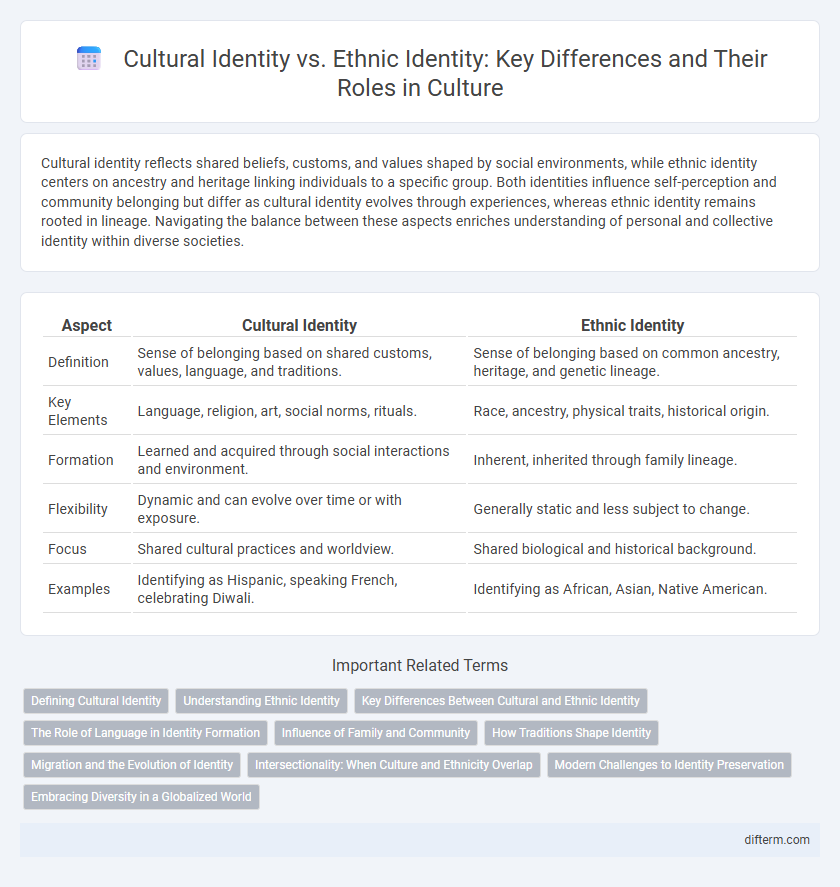Cultural identity reflects shared beliefs, customs, and values shaped by social environments, while ethnic identity centers on ancestry and heritage linking individuals to a specific group. Both identities influence self-perception and community belonging but differ as cultural identity evolves through experiences, whereas ethnic identity remains rooted in lineage. Navigating the balance between these aspects enriches understanding of personal and collective identity within diverse societies.
Table of Comparison
| Aspect | Cultural Identity | Ethnic Identity |
|---|---|---|
| Definition | Sense of belonging based on shared customs, values, language, and traditions. | Sense of belonging based on common ancestry, heritage, and genetic lineage. |
| Key Elements | Language, religion, art, social norms, rituals. | Race, ancestry, physical traits, historical origin. |
| Formation | Learned and acquired through social interactions and environment. | Inherent, inherited through family lineage. |
| Flexibility | Dynamic and can evolve over time or with exposure. | Generally static and less subject to change. |
| Focus | Shared cultural practices and worldview. | Shared biological and historical background. |
| Examples | Identifying as Hispanic, speaking French, celebrating Diwali. | Identifying as African, Asian, Native American. |
Defining Cultural Identity
Cultural identity is defined by shared values, traditions, languages, and customs that shape a group's collective sense of belonging and self-understanding. It extends beyond ethnic identity, which is primarily rooted in ancestry, genetics, and lineage, by encompassing social influences, historical experiences, and symbolic expressions. This dynamic and multifaceted concept influences individuals' worldviews and interactions within diverse societies.
Understanding Ethnic Identity
Ethnic identity encompasses a person's connection to shared ancestry, language, and historical heritage, shaping their sense of belonging within a particular group. It involves self-identification and recognition by others based on cultural traditions, customs, and social practices that distinguish the group from others. Understanding ethnic identity requires exploring how these elements influence social cohesion, personal identity, and intergroup relations in multicultural societies.
Key Differences Between Cultural and Ethnic Identity
Cultural identity refers to the shared beliefs, values, customs, and behaviors that define a group, often shaped by social experiences and environment, while ethnic identity is rooted in inherited traits such as ancestry, language, and physical characteristics. Cultural identity can evolve over time through interaction and adaptation, whereas ethnic identity tends to be more stable and linked to lineage and heritage. Understanding the distinction between these identities is crucial for studying social dynamics and individual self-concept within multicultural societies.
The Role of Language in Identity Formation
Language serves as a fundamental pillar in shaping both cultural and ethnic identity, functioning as a primary medium for transmitting traditions, values, and collective memory. It reinforces a sense of belonging and continuity within a community, allowing individuals to connect with their heritage through shared linguistic practices. The nuances of dialect, expressions, and storytelling embedded in language contribute to the unique identity of ethnic groups while also influencing broader cultural affiliations.
Influence of Family and Community
Family and community play a central role in shaping both cultural and ethnic identities by transmitting language, traditions, and shared values across generations. These social units foster a sense of belonging and collective memory, reinforcing cultural practices specific to ethnic groups while allowing individual identity expression. The dynamic interaction within families and communities significantly influences how cultural and ethnic identities evolve and are maintained over time.
How Traditions Shape Identity
Traditions play a crucial role in shaping both cultural and ethnic identities by preserving shared practices, values, and rituals that connect individuals to their community's history. These customs foster a sense of belonging and continuity, reinforcing unique cultural narratives and collective memory. Through participation in traditional ceremonies, language, and art, individuals express and maintain the distinctiveness of their cultural and ethnic heritage.
Migration and the Evolution of Identity
Migration profoundly influences the evolution of cultural identity by blending diverse traditions, languages, and customs, reshaping individual and collective senses of belonging. Ethnic identity often maintains foundational ancestral ties, yet migratory experiences catalyze dynamic reinterpretations and hybrid identities. This interplay highlights the fluidity of identity amid global mobility and the persistent negotiation between heritage and adaptation.
Intersectionality: When Culture and Ethnicity Overlap
Cultural identity and ethnic identity often intersect, creating complex layers of self-expression influenced by shared traditions, language, and historical experiences. This intersectionality highlights the multifaceted nature of individual and collective identities, where cultural practices may transcend or reinforce ethnic boundaries. Understanding this overlap is crucial in appreciating the diverse ways people navigate their heritage and social environments.
Modern Challenges to Identity Preservation
Modern challenges to cultural and ethnic identity preservation include globalization, which accelerates cultural homogenization, threatening unique traditions and languages. Urbanization and digital media further dilute ethnic distinctions by blending diverse cultural influences and promoting mainstream norms. Efforts to preserve heritage face obstacles as younger generations navigate hybrid identities amid rapid sociocultural changes.
Embracing Diversity in a Globalized World
Cultural identity shapes individuals' sense of belonging through shared customs, traditions, and values, while ethnic identity connects them to ancestral heritage and lineage. Embracing diversity in a globalized world requires recognizing the dynamic interplay between these identities to foster inclusivity and mutual respect. Promoting cultural competence and intercultural dialogue enhances social cohesion and enriches collective human experience.
cultural identity vs ethnic identity Infographic

 difterm.com
difterm.com